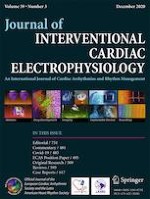Erschienen in:

02.01.2020
Clinical impact of rapid ventricular pacing on the left atrial posterior wall isolation by a cryoballoon application: a randomized controlled trial
verfasst von:
Takuro Nishimura, Kaoru Okishige, Yasuteru Yamauchi, Takatoshi Shigeta, Rena Nakamura, Tastuhiko Hirao, Tetsuo Sasano, Kenzo Hirao
Erschienen in:
Journal of Interventional Cardiac Electrophysiology
|
Ausgabe 3/2020
Einloggen, um Zugang zu erhalten
Abstract
Purpose
Rapid ventricular pacing (RVP) was reported to improve the cooling effects of the cryoballoon (CB). The aim of this study was to investigate the safety and efficacy of RVP for left atrial posterior wall isolation (PWI) by the CB.
Methods
One hundred consecutive patients (males 80, mean age 63 ± 10 years) with persistent atrial fibrillation underwent left atrial roof (LA-RB) and bottom block line (LA-BB) creation by CB to achieve PWI. Patients were randomized into two groups according to whether they underwent PWI with (RVP group, n = 50) or without RVP (control group, n = 50).
Results
The nadir CB temperature (NCT) during the LA-RB and LA-BB creation was significantly lower in the RVP group than control group (LA-RB − 45.7 °C and − 43.9 °C, p < 0.001, and LA-BB − 42.4 °C and − 40.0 °C, p < 0.001). The success rate of the LA-RB creation was significantly higher in the RVP group than the control group (98% vs. 88%, p = 0.039), however, there were no significant differences regarding the LA-BB creation (66% vs. 52%, p = 0.15) and PWI (66% vs. 50%, p = 0.1) between the two groups. The PWI success rate did not differ whether CB freezing was prematurely terminated due to an excessive luminal esophageal temperature (LET) drop in the RVP group (65.8% vs. 66.7%, respectively, p = 0.96).
Conclusions
RVP significantly decreased the NCT during the CB application resulting in the significant improvement of success rate of the LA-RB. The advantage of RVP in terms of the accomplishing PWI was not affected even when the CB freezing was prematurely terminated due to an excessive LET drop.











